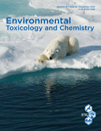Environmental Toxicology and Chemistry 31(12)
Overview of articles on POPs in a new issue of the Science of The Total Environment journal.

(pages 2683–2688)
Keith A. Maruya, Doris E. Vidal-Dorsch, Steven M. Bay, Jeong W. Kwon, Kang Xia and Kevin L. Armbrust
- To investigate the occurrence and bioaccumulation of organic contaminants of emerging concern (CECs) near four major wastewater ocean outfalls in the Southern California Bight, more than 75 pharmaceutical and personal care products, current-use pesticides, and industrial/commercial chemicals were analyzed in sediment and liver tissues of hornyhead turbot (Pleuronichthys verticalis) using gas and liquid chromatography–mass spectrometry.
(pages 2763–2770)
Ryan R. Otter, Erika A. Schreiber, Peter van den Hurk and Stephen J. Klaine
- Biomarkers can be used as tools to help determine ecological exposure in watershed assessments. In the present study, metallothionein and fixed wavelength bile fluorescence for two-, four-, and five-ring hydrocarbons were used as biomarkers of exposure in largemouth bass (Micropterus salmoides) in the Reedy River watershed located in South Carolina, USA.
PCDD/F release during benthic trawler-induced sediment resuspension
(pages 2780–2787)
Ian J. Allan, Hans C. Nilsson, Ingrid Tjensvoll, Clare Bradshaw and Kristoffer Næs
- Benthic trawling can cause the resuspension of large amounts of sediments. Such regular practice in the Grenland fjord system in the south of Norway has the potential to affect the fate, movement, and bioavailability of sediment-associated polychlorinated dibenzo-p-dioxins and dibenzofurans (PCDD/Fs). A novel mode of exposing passive sampling devices consisting of towing semipermeable membrane devices attached to the trawl net was used to gauge in situ changes in the freely dissolved concentration of PCDD/Fs on benthic trawler–induced sediment resuspension.
(pages 2788–2797)
Ève A.M. Gilroy, Derek G.C. Muir, Mark E. McMaster, Colin Darling, Linda M. Campbell, Shane R. de Solla, Joanne L. Parrott, Scott B. Brown and James P. Sherry
- Whole-body polychlorinated biphenyls (ΣPCBs) and plasma hydroxylated PCBs (OH-PCBs) concentrations were determined in brown bullhead (Ameiurus nebulosus) from Wheatley Harbour, Ontario, Canada. Elevated ΣPCBs in Wheatley Harbour are suspected to have originated from industrial waste disposal and/or discharges from nearby fish processing through discarding of fish remains.
(pages 2821–2827)
Charles P. Madenjian, Solomon R. David, Richard R. Rediske and James P. O'Keefe
- Lake trout (Salvelinus namaycush) were fed bloater (Coregonus hoyi) in eight laboratory tanks over a 135-d experiment. At the start of the experiment, four to nine fish in each tank were sacrificed, and the concentrations of 75 polychlorinated biphenyl (PCB) congeners within these fish were determined.
19.11.2012




